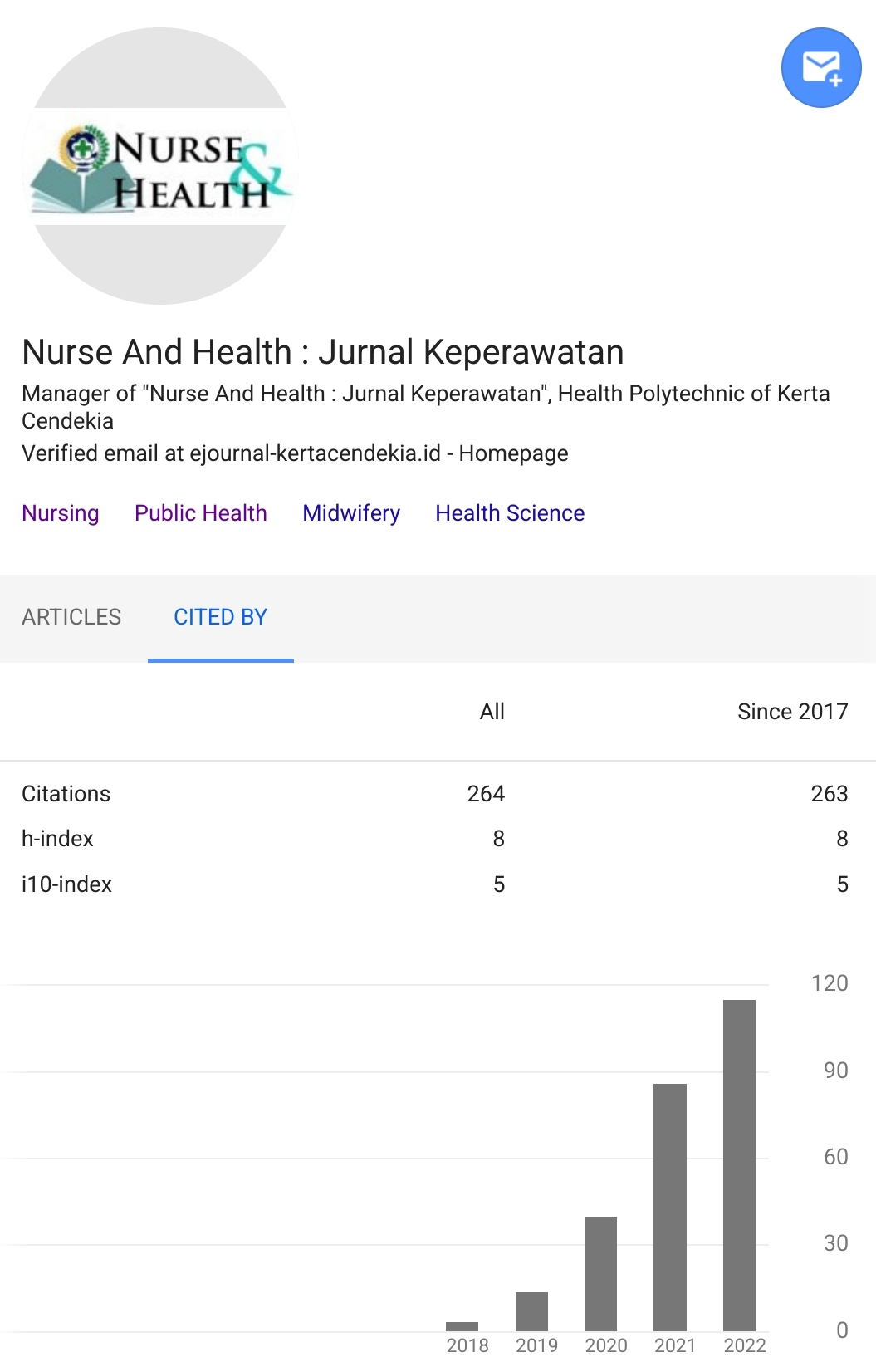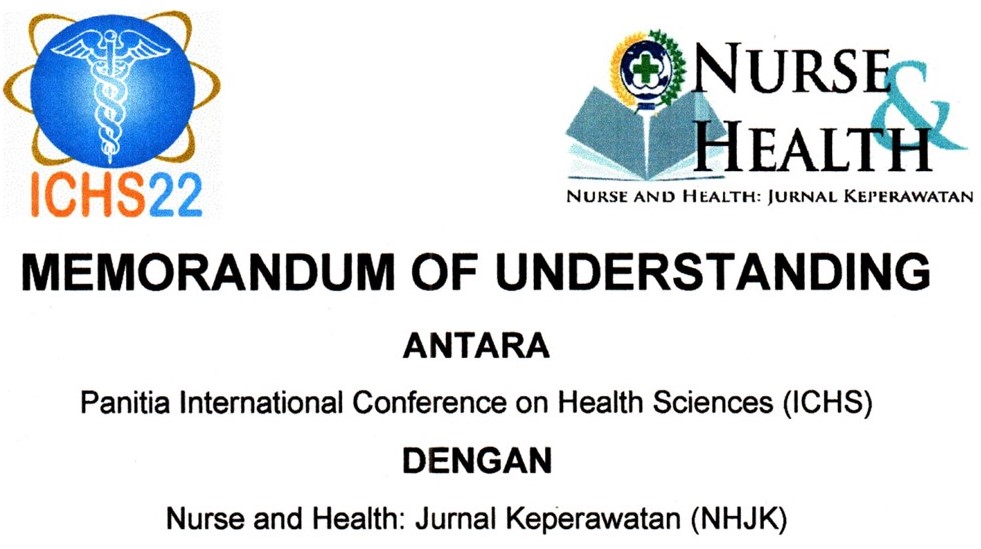THE EXPERIENCE OF NURSE ANESTHETISTS IN EDUCATING PATIENTS AND FAMILIES: A QUALITATIVE STUDY
Abstract
Background: Effective communication is one of the competencies of nurse anesthetists; they must also play the role of educator to the patients, meaning that they have to disseminate knowledge related to anesthesia to the patients that will undergo the anesthesia process. The communication done by nurse anesthetists may help reduce patients’ anxiety and prepare patients for the post-anesthesia process. Objectives: This study explores the experience of nurse anesthetists in educating patients and families. Methods: This study employed a phenomenological qualitative approach involving 12 nurse anesthetists in Bali. The inclusion criteria for respondents were nurse anesthetists working in the operating room and nurse anesthetists having STRPA and SIPPA. This study took place for 3 months in 2 hospitals. Data were collected through semi-structured interviews with 8 questions. Data collected using in-depth interviews were analyzed using the Colaizzi method. Results: The themes that emerged from this study were “workload of nurse anesthetists”, “uncertainty in documentation results”, and “obstacles in educating patients on anesthesia” that included challenges from patients’ family members, patients, patient management systems, and nurse anesthetists. Conclusion: Limited nurse anesthetists have caused an increased workload, so education related to anesthesia becomes insufficient. vDownloads
References
Abdul-Kareem, K. et al. (2019). Medical-surgical nurses’ documentation of client teaching and discharge planning at a Jamaican hospital. International Nursing Review. https://doi.org/10.1111/inr.12487 DOI: https://doi.org/10.1111/inr.12487
Agustina, E. et al. (2020). Asesmen Pra-Anestesi: Bukan Sekedar Kepatuhan. The Journal of Hospital Accreditation, 2(02), 32–40. DOI: https://doi.org/10.35727/jha.v2i02.52
Amurwani, F. S., & Rofi’i, M. (2018). Faktor Penyebab Penundaan Operasi Elektif di Rumah Sakit Pemerintah di Semarang. Jurnal Ilmu Keperawatan Medikal Bedah, 1(1), 17–25. DOI: https://doi.org/10.32584/jikmb.v1i1.95
Bulka, C. M. et al. (2014). Regional anesthesia, time to hospital discharge, and in-hospital mortality: A propensity score-matched analysis. Regional Anesthesia and Pain Medicine. https://doi.org/10.1097/AAP.0000000000000121 DOI: https://doi.org/10.1097/AAP.0000000000000121
Chabibi, M. et al. (2019). Hubungan Komunikasi Terapeutik Perawat terhadap Kepuasan Pasien Pre Operasi di Instalasi Bedah Sentral RS PKU Muhammadiyah Gombong. Proceeding of The URECOL, 464–472.
Chuandy, I., & Santosa, S. B. (2015). Konsep Pain-Free Hospital. Cermin Dunia Kedokteran, 42(3), 209–212.
Forero, R. et al. (2018). Application of four-dimension criteria to assess rigour of qualitative research in emergency medicine. BMC Health Services Research, 18(1), 1–11. DOI: https://doi.org/10.1186/s12913-018-2915-2
Holloway, I., & Wheeler, S. (2010). Qualitative Research in Nursing and Health (3rd ed.). Wiley-Blackwell.
Hrad. V, W. S. . (2014). Immediate Discharge From Post Anesthesia Care Unit to Home Following Laparoscopic Appendectomy for Acute Non-Perforated Appendicitis. Journal of Surgical Research. DOI: https://doi.org/10.1016/j.jss.2013.11.629
Keputusan Menteri Kesehatan Republik Indonesia Tentang Standar Profesi Penata Anestesi, Pub. L. No. NOMOR HK.01.07/MENKES/722/2020 (2020).
Krupic, F. et al. (2018). Nurses’ Experience of Patient Care in Multibed Hospital Rooms: Results From In-Depth Interviews With Nurses After Further Education in Anesthesia. Journal of Perianesthesia Nursing. https://doi.org/10.1016/j.jopan.2016.09.003 DOI: https://doi.org/10.1016/j.jopan.2016.09.003
Masjedi, M. et al. (2017). Evaluation of anxiety and fear about anesthesia in adults undergoing surgery under general anesthesia. Acta Anaesthesiol Belg, 68(1), 25–29.
Neft, M. et al. (2013). The revised scope of nurse anesthesia practice embodies the broad continuum of nurse anesthesia services. AANA Journal.
Neubauer, B. E. et al. (2019). How phenomenology can help us learn from the experiences of others. Perspectives on Medical Education. https://doi.org/10.1007/s40037-019-0509-2 DOI: https://doi.org/10.1007/S40037-019-0509-2
Noviari, E. A., & Susanti, D. D. (2015). Faktor-Faktor Yang Mempengaruhi Kelengkapan Dokumentasi Asuhan Keperawatan Di Ruang Bedah RSUD Dr. Soekardjo Kota Tasikmalaya. Media Informasi, 11(1), 27–38. DOI: https://doi.org/10.37160/bmi.v11i1.27
Safrina, N., & Putra, A. (2016). Persepsi Perawat Pelaksana Terhadap Pentingnya Discharge Planning Di RSUDZA Banda Aceh Rsudza Banda Aceh. Jurnal Iilmiah Mahasiswa Fakultas Keperawatan.
Siti, M. et al. (2016). Komunikasi terapeutik perawat berhubungan dengan kepuasan pasien. Jurnal Ners Dan Kebidanan Indonesia, 4(1), 30–34. DOI: https://doi.org/10.21927/jnki.2016.4(1).30-34
Sulastri, Eko Trilianto, A., & Ermaneti, Y. (2019). Pengaruh Komunikasi Terapeutik Perawat terhadap Tingkat Kecemasan pada Pasien Pre Operasi. In Jurnal Keperawatan Profesional (JKP). DOI: https://doi.org/10.33650/jkp.v7i1.503
Sylvana, Y. et al. (2021). Legal Delegasi (Pelimpahan Wewenang Medis) Dokter Kepada Perawat Ditinjau dari Perspektif Hukum. Cerdika: Jurnal Ilmiah Indonesia, 1(12), 1632–1646. DOI: https://doi.org/10.36418/cerdika.v1i12.217
Usnadi, U. et al. (2018). Kecemasan Preoperasi pada Pasien di Unit One Day Surgery(ODS). Jurnal Keperawatan ’Aisyiyah.
Walujo, A. M., & Satya, I. M. H. (2020). Anestesi pada Pelayanan Bedah Sehari (Outpatient Anesthesia). Cermin Dunia Kedokteran, 47(4), 250–274.
Wijayanto, T. (2017). Pendidikan Kesehatan Terhadap Tingkat Kecemasan Pada Pasien Preoperasi Kanker Payudara. Jurnal Ilmiah Kesehatan. https://doi.org/10.35952/jik.v6i1.84 DOI: https://doi.org/10.52822/jwk.v3i1.70
Zavala, S., & Shaffer, C. (2011). Do Patients Understand Discharge Instructions? Journal of Emergency Nursing. https://doi.org/10.1016/j.jen.2009.11.008 DOI: https://doi.org/10.1016/j.jen.2009.11.008
Copyright (c) 2023 I Wayan Agus Maharyawan, I Ketut Swarjana, I Made Rismawan, Gst. Kade Adi Widyas Pranata

This work is licensed under a Creative Commons Attribution-NonCommercial 4.0 International License.
Authors who publish with Nurse and Health: Jurnal Keperawatan agree to the following terms:
- Authors retain copyright licensed under a Creative Commons Attribution-NonCommercial 4.0 (CC BY-NC 4.0), which allows others to remix, tweak, and build upon the authors' work non-commercially, and although the others' new works must also acknowledge the authors and be non-commercial, they don't have to license their derivative works on the same terms.
- Authors are permitted and encouraged to post their work online (e.g., in institutional repositories or on their website) prior to and during the submission process, as it can lead to productive exchanges, as well as earlier and greater citation of published work (See The Effect of Open Access). Authors can archive pre-print and post-print or publisher's version/PDF.








_resize1.jpg)















